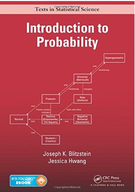In the game called Chutes and Ladders, players try to be first to reach a certain
Chapter 11, Problem 21(choose chapter or problem)
In the game called Chutes and Ladders, players try to be first to reach a certain destination on a board. The board is a grid of squares, numbered from 1 to the number of squares. The board has some chutes and some ladders, each of which connects a pair of squares. Here we will consider the one player version of the game (this can be extended to the multi-player version without too much trouble, since with more than one player, the players simply take turns independently until one reaches the destination). On each turn, the player rolls a fair die, which determines how many squares forward to move on the grid, e.g., if the player is at square 5 and rolls a 3, then he or she advances to square 8. If the resulting square is the base of a ladder, the player gets to climb the ladder, instantly arriving at a more advanced square. If the resulting square is the top of a chute, the player instantly slides down to the bottom of the chute. This game can be viewed naturally as a Markov chain: given where the player currently is on the board, the past history does not matter for computing, for example, the probability of winning within the next 3 moves. Consider a simplified version of Chutes and Ladders, played on the 3 3 board shown below. The player starts out at square 1, and wants to get to square 9. On each move, a fair coin is flipped, and the player gets to advance 1 square if the coin lands Heads and 2 squares if the coin lands Tails. However, there are 2 ladders (shown as upward-pointing arrows) and 2 chutes (shown as downward-pointing arrows) on the board. 7 8 9 6 5 4 1 2 3 (a) Explain why, despite the fact that there are 9 squares, we can represent the game using the 5 5 transition matrix Q = 0 BBBBBBBBBBBB@ 0 0.5 0.50 0 0 00.5 0.5 0 0.50 00.5 0 0.50 0 00.5 00001 1 CCCCCCCCCCCCA . (b) Find the mean and variance for the number of times the player will visit square 7, without using matrices or any messy calculations. The remaining parts of this problem require matrix calculations that are best done on a computer. You can use whatever computing environment you want, but here is some information for how to do it in R. In any case, you should state what environment you used and include your code. To create the transition matrix in R, you can use the following commands: a
Unfortunately, we don't have that question answered yet. But you can get it answered in just 5 hours by Logging in or Becoming a subscriber.
Becoming a subscriber
Or look for another answer
